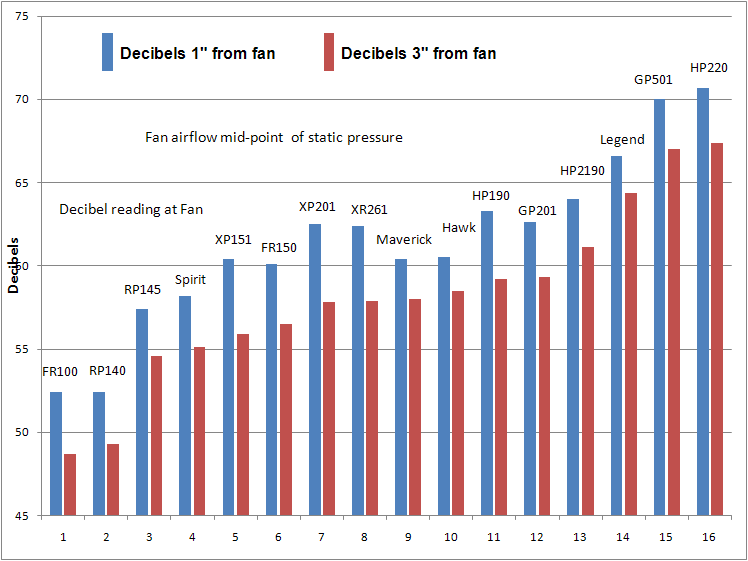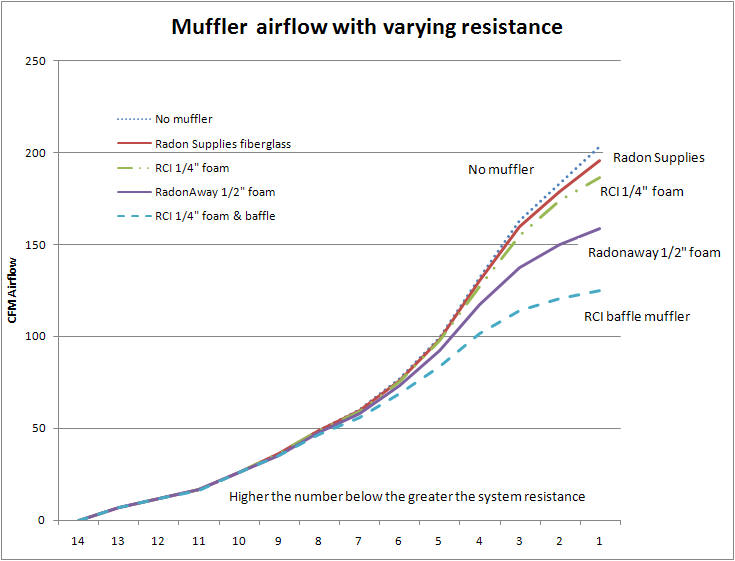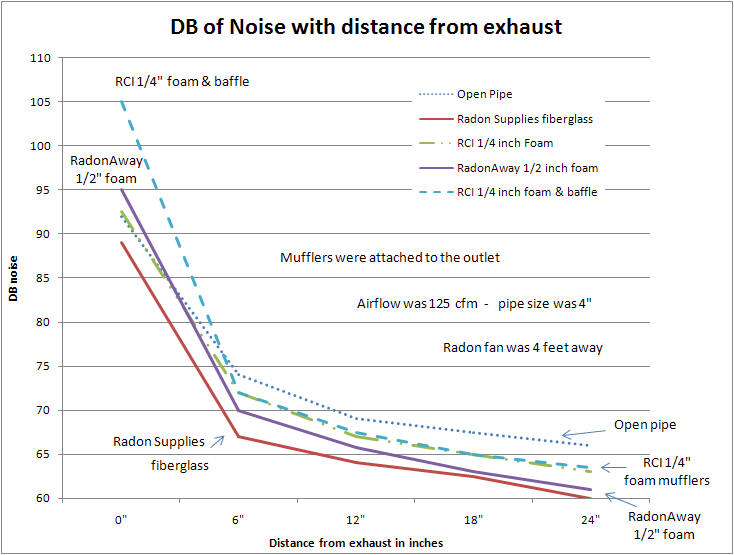 |
 |
Bill Brodhead WPB Enterprises Inc
Radon & Vapor Intrusion |
 |
Reducing Radon Fan or System Noise |
 |
|
WPB Home Page Choosing best Fan to use All Info pages Pipe & Fitting Pressure Drop Fan Testing method Operating Cost |
The Noise ProblemThere are a number of contributing factors with system noise problems. Click underlined headings for more details below.
Fan Motor Noise - This is closely related to the fan wattage.
Fan induced vibration - This is due to improper fan blade balance.
Air Flow Noise - Due to airflow speed through the pipe or under membranes.
Competing Noise - What other noise is happening?
Occupant Distance from System - Where is system located?
Occupant Sensitivity Using a Quieter Fan or wrapping it with insulationRadon fan motors vary considerably in the noise they generate. Often a fan with higher wattage than required is used because the installer does not measure the depressurization induced under the slab. A lower wattage fan can almost always be installed in standard radon sub-slab depressurization systems if there is good aggregate under the slab and the slab does not have large open cracks or other unsealed openings. A 20 watt radon fan can save $500 in electrical cost over ten years and is considerably quieter. Visit the Radon Fan Performance page and look up your radon fan wattage. Then check out the fans below. In general the lower the fan wattage the quieter the fan. These fans were tested with ten feet of piping and a muffler on the intake and exhaust to reduce this noise to a minimum. A sound meter was then held 1" from the fan and 3" from the fan when the fan was operating at it's midpoint of it's performance curve.
Before installing a low wattage fan you should drill a small test hole (5/16" or 1/4") through the slab at the farthest distance from the suction hole and measure the sub-slab negative pressure under the slab. If you have greater than 5 pascals (0.020") negative pressure under the slab you should be able to install a 20 watt fan without significant change to the radon reduction. The u-tube will generally read 30% to 50% less. The 20 watt fans will easily pay for cost of the fan in electrical savings in several years. If the radon fan is located in the attic of the house or garage you can wrap the fan with fiberglass insulation. The air flowing through the fan will maintain the fan temperature. I have never found a radon fan more than a bit warm even if the motor has been stalled by some blockage so there appears to be no concern about causing a fire from the fan overheating. Fan Induced VibrationThere is always some vibration occurring as the fan operates. The rubber boots used to attach the fan to the pipe transfer lots of fan vibration. Place your hand on the fan. Then place you hand on any building component that the piping above or below the fan is attached to. On outside mounted fans feel the siding for vibration next to the first fan bracket above the fan and where the pipe enters the building. If the fan is in the attic feel any framing that the fan is attached to or the pipe rubs up against. If you feel any vibration of building components you can be sure it is being transferred back into the building. Feel the drywall inside the home that is closest to the fan location for vibration. If the fan itself is touching any building components adjust the fan supports so it does not do this. You can also loosen or sometimes even remove the clamps that hold the pipe above outside mounted fans. Check for change in vibration transfer back into the building. If the vibration is less or gone then determine if the support can be eliminated. If the supports are needed then try losely installing a cushion like material such as closed cell foam backer rod between the bracket and the pipe. Occasionally during the system installation or after the system has been running something sticks to the fan blades causing an increased vibration. Often bugs and debris accumulates on fan blades. Loosen the rubber boots holding the fan to the system piping and remove the fan. Carefully inspect the blades and scrap them clean with a screwdriver blade or other tool. Shake the fan and run it to clear out any debris in the fan. Be careful not to suck more debris in, especially fingers. If you bench test a dozen identical radon fans as I have, you will find they vary in the amount of vibration. Some radon fans have small clips placed on the fan blades. You can try by trial and error to adjust the clip to the next or previous blade and run the fan to determine if it is getting better or worse. Be sure to mark the original location of the clip. Air Flow NoiseFan systems installed outside should not be audible inside unless there is an adjacent window that the occupants occassionally open and they spend time near to. This noise would be from both airflow and the fan. A lower wattage fan would be the best solution. If the noise transfer is through an open second floor window then it is likely to be the piping airflow noise and the exhaust noise. The exhaust piping could be switched to thicker walled PVC piping or even a muffler on the exhaust stack if aesthetics is not a concern. PIPE THICKNESS: Radon PVC piping is either 1/8 inch walled schedule 20 also known as sewer and drain (S&D) or 1/4" walled schedule 40 DVW or schedule 40 foamcore pipe. Using thicker walled pipe, especially the foamcore, will partially reduce airflow noise transmission. SYSTEMS ROUTED THROUGH CLOSETS: If the house has a single floor section (ranch style) the system can be piped up through a closet to the attic. Avoid using a master bedroom closet. A hall closet is the best choice for minimal noise impact. INSULATING THE PIPE: Piping that is routed through a space that needs to minimize airflow noise can be insulated for noise reduction. Sliding the next size larger flexible insulated duct over the pipe in the area that needs to have quieter piping can be very effective. Using closed cell foam or thicker walled pipe is less effective. CRAWL SPACE MEMBRANES: If the home has a dirt floor crawl space the airflow noise from a sub-membrane suction system can sometimes be audible in the living area above the crawl space. Open face fiberglass insulation can be placed on top of the membrane or in the joist cavities above the suction location to dampen the noise. The smaller the pipe size drawing air from under the membrane the quieter the air flow noise. To reduce sub-membrane noise, downsize the pipe under the membrane to a 2" pipe which can move up to 50 cfm or a 1.5 inch pipe that can move up to 35 cfm of air. ROUTING NEW CONSTRUCTION PIPING: The air moving through a radon pipe has enough noise to be carried through drywall. Try to not route new construction passive radon pipes through walls adjacent to a bedroom, especially the master bedroom. Builders rarely think about this detail. If you can hear air flow noise through the drywall your only partial solution is installing a lower wattage fan in the attic. If it is really bothersome to the owner the system may need to be re-piped up the outside of the home. EXHAUST MUFFLERS: Companies that supply radon products manufacturer different style air flow mufflers. Some of the mufflers restrict the airflow at higher airflow speeds. This would only affect high airflow systems. Their effectiveness for noise reduction also varies. In general a muffler will not reduce the airflow noise coming from the piping or the fan noise itself. The mufflers will however lower the exhaust noise if they are placed near the exhaust port. The actual noise reduction is moderate but the sound pitch is lowered which makes the noise less offensive. System exhaust noise is usually only bothersome if the exhaust is at the first floor roof and the exhaust pipe is visible from a location that is frequently occupied. A 2nd floor window that looks at a radon exhaust pipe on the garage roof or an exhaust out of a ranch roof that is visible from a rear deck would be good canidates for a muffler. The best muffler noise reduction is with the muffler installed on the end of the exhaust pipe with no chimney cap so that air flow is straight up. We have installed the muffler on the exhaust port on the roof for maximum noise reduction even though it looks a bit out of place.
This chart belowshows there is increasing resistance to airflow for some mufflers when the system airflow is above 50 cfm.
This next chartdepicts the actual measured sound in decibels (db) made using an Extech Sound Level Meter #407740. The airflow was 125 cfm for each measurement made. Each muffler was installed on the outlet of the pipe with the fan motor 4 feet downstream and the system intake 14 feet away. The intake had a separate muffler attached to minimize the noise interference from this source. Note that although the db reduction was modest each muffler lowered the pitch of the sound.
Here are some pictures of the mufflers currently offered for sale. |
 |
|
RadonSupplies has a 1 inch fiberglass lined muffler inside a 6 inch PVC S&D pipe. This muffler provided the least airflow resistance and the greatest DB reduction. |
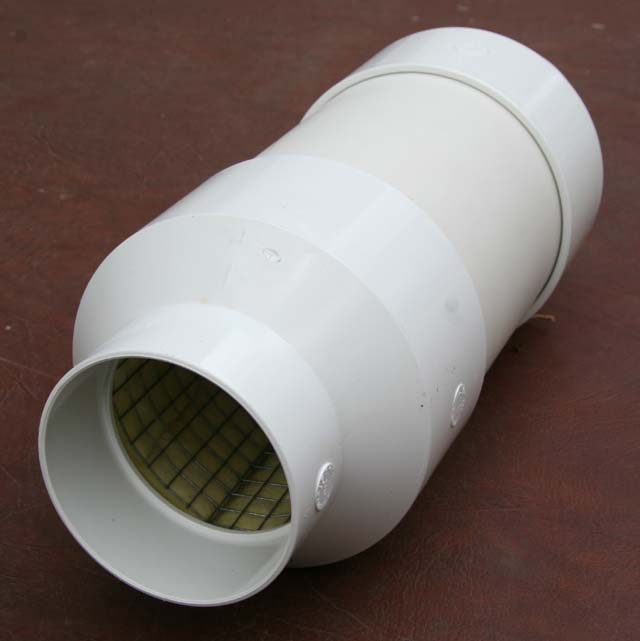 |
 |
|
RadonAway offers a 4" PVC pipe lined with 1/2" foam. This muffler has the second greatest flow restriction but provides second best noise reduction. |
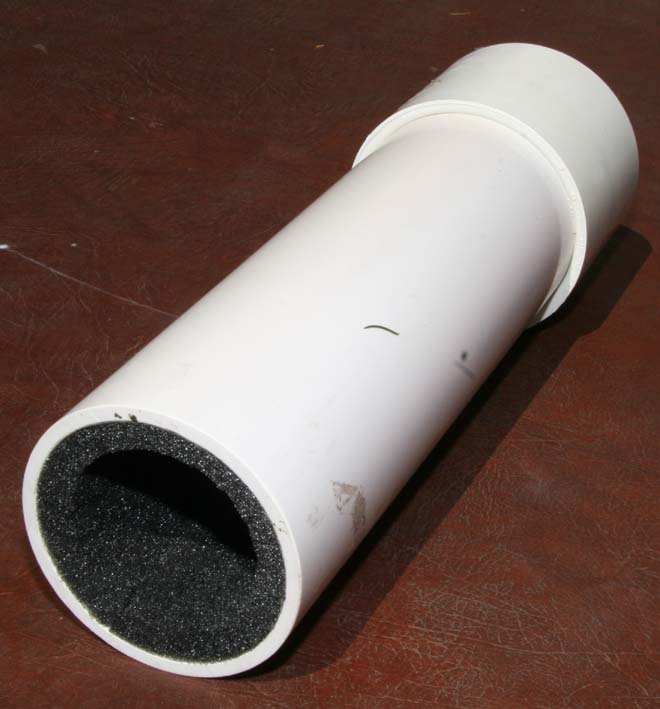
|
 |
|
The RCI baffled muffler is a 5" PVC pipe lined with 1/4" foam. This muffler had the greatest flow restriction and the same noise reduction as the straight through RCI muffler. |
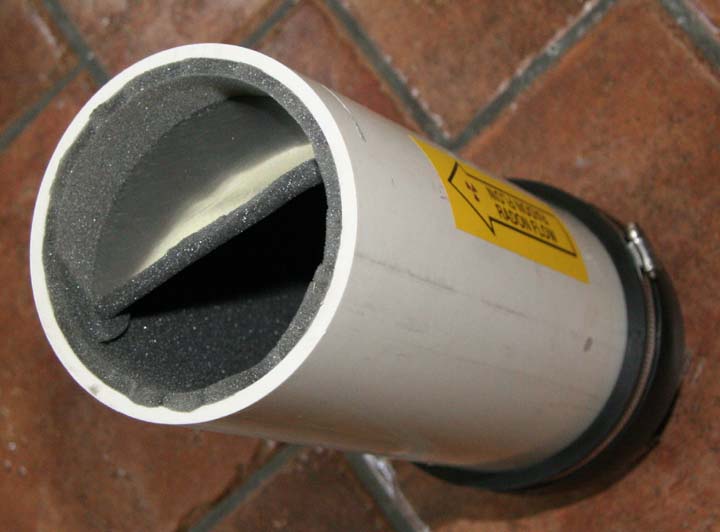
|
 |
|
This RCI muffler uses a 4" PVC pipe that is lined with 1/4" foam. Both 1/4" foam lined mufflers had the least DB noise reduction. |
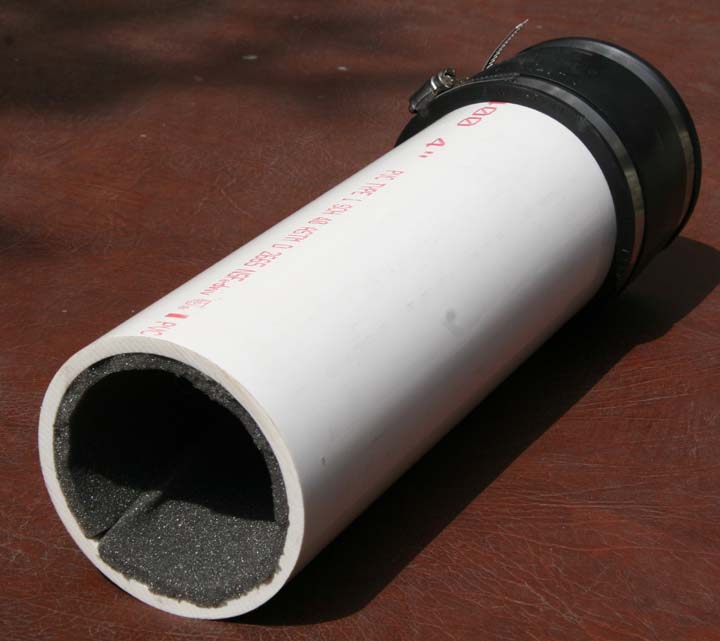
|
 |
|
Radon Job Photos Fan Performance Lots of Other Info WPB Home |
 |
|
|
|
Radon mitigation call Integra Environmental 610 346-8004 |
